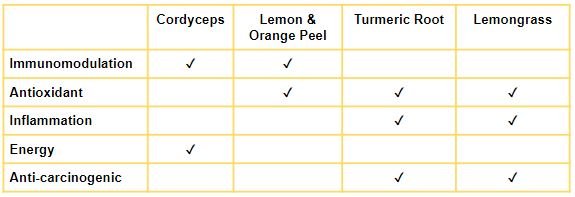The Top Health Benefits of ZOM Mushroom Tea: Citrusceps
Citrusceps is a citrusy mushroom tea blend that features Cordyceps mushroom (Cordyceps militaris) as its main ingredient, and is supplemented with lemon peel, orange peel, turmeric root, and lemongrass. Cordyceps is a fungi known to parasitize certain insects, but when ingested by humans, it contains several health benefits, making it a medicinal mushroom, too. Read on to learn about how drinking Citrusceps mushroom tea can boost your health and wellbeing. This article will focus on the benefits of the ingredients in the mushroom tea that have the most scientific evidence and study behind them.
Cordyceps is a diverse genus of mushroom, containing about 600 species. The species used in Citrusceps tea, C. militaris, is the second-most studied of the known species. There is a growing body of evidence that Cordyceps are beneficial for energy and endurance. In a 2020 study, animal subjects were administered C. militaris extract and then their grip strength was evaluated. Blood sample analysis revealed that exercise performance was enhanced due to upregulation of the ATP-generating pathway. ATP (adenosine triphosphate) is the principal molecule for the cellular storage and transfer of energy, and is used in processes like muscle contraction. A 2010 study examined the effect of Cordyceps extract on macrophages. Macrophages are cells that have several functions which include the killing and removal of pathogens, as well as production of antigens, and are therefore crucial components of the immune system. They also work with T cells to produce cytokines, which are small proteins that signal for immune and inflammation responses in the body. The study found that macrophage activity was increased when macrophages were dosed with Cordyceps extract.
Lemon and orange peel are naturally high in vitamin C, which is essential for a healthy and balanced diet. Vitamin C is especially recognized for its role in maintaining a healthy immune system, reducing the severity of allergic reactions, and helping to fight off infection. It is also an antioxidant, and used as a therapeutic treatment for several diseases and disorders.
An important active compound in turmeric root is curcumin, which is a natural anti-inflammatory. Even low-level chronic inflammation has been linked to diseases such as heart disease, cancer, and Alzheimer’s, so the inclusion of anti-inflammatory compounds in your daily diet is key to good health.
Lemongrass is a good source of a phytonutrient called flavonoids, which are a compound that has been well-studied for its antioxidant, anti-inflammatory, and anti-carcinogenic properties. The role of flavonoids in disrupting and inhibiting key enzyme pathways gives it these properties.
It’s important to note that when brewing medicinal mushroom tea, the process is different than the average tea-drinker may be used to. To get the most out of our tea blends, be sure to steep your tea for a full 60 minutes. This period of time allows for the mushrooms to break down and increase the bioavailability of compounds for ingestion.
The founder of Zoom Out Mycology and creator of Citrusceps, Bashira Muhammad, shares her experience with this mushroom tea blend: Citrusceps is a warm and earthy, yet bright tea. It was formulated to energize and support endurance. Cordyceps is a very earthy mushroom and the herbs offer a source of brightness. I drink Citrusceps in small doses when in a celebratory mood to recognize progress between months of consistent hard work.
Medicinal properties found within the Citrusceps tea blend according to each ingredient.
Sources
Chambial et al, 2013. “Vitamin C in Disease Prevention and Cure: An Overview.” Indian Journal of Clinical Biochemistry. DOI: 10.1007/s12291-013-0375-3
Shin et al, 2010. “Immunostimulatory Effects of Cordyceps militaris on Macrophages through the Enhanced Production of Cytokines via the Activation of NF-κB.” Immune Network. DOI: 10.4110/in.2010.10.2.55
Choi et al, 2020. “Beneficial Effect of Cordyceps militaris on Exercise Performance via Promoting Cellular Energy Production.” Mycobiology. https://doi.org/10.1080/12298093.2020.1831135
Marchio et al, 2019. “Targeting Early Atherosclerosis: A Focus on Oxidative Stress and Inflammation.” Oxidative Medicine and Cellular Longevity. DOIi: 10.1155/2019/8563845
Slika & Patra, 2020. “Traditional Uses, Therapeutic Effects and Recent Advances of Curcumin: A Mini-Review.” Mini-Reviews in Medicinal Chemistry. DOI: 10.2174/1389557520666200414161316
Panche et al, 2016. “Flavonoids: an overview.” Journal of Nutritional Science. DOI: 10.1017/jns.2016.41



